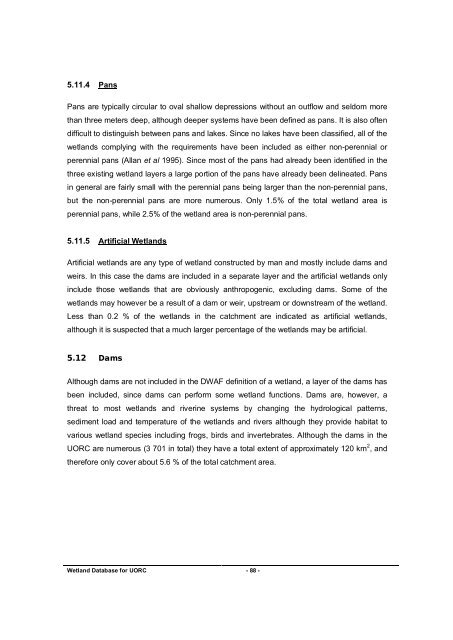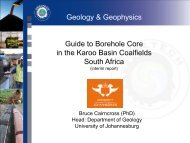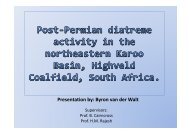coaltech upper olifants river catchment wetland inventory ...
coaltech upper olifants river catchment wetland inventory ...
coaltech upper olifants river catchment wetland inventory ...
Create successful ePaper yourself
Turn your PDF publications into a flip-book with our unique Google optimized e-Paper software.
5.11.4 Pans<br />
Pans are typically circular to oval shallow depressions without an outflow and seldom more<br />
than three meters deep, although deeper systems have been defined as pans. It is also often<br />
difficult to distinguish between pans and lakes. Since no lakes have been classified, all of the<br />
<strong>wetland</strong>s complying with the requirements have been included as either non-perennial or<br />
perennial pans (Allan et al 1995). Since most of the pans had already been identified in the<br />
three existing <strong>wetland</strong> layers a large portion of the pans have already been delineated. Pans<br />
in general are fairly small with the perennial pans being larger than the non-perennial pans,<br />
but the non-perennial pans are more numerous. Only 1.5% of the total <strong>wetland</strong> area is<br />
perennial pans, while 2.5% of the <strong>wetland</strong> area is non-perennial pans.<br />
5.11.5 Artificial Wetlands<br />
Artificial <strong>wetland</strong>s are any type of <strong>wetland</strong> constructed by man and mostly include dams and<br />
weirs. In this case the dams are included in a separate layer and the artificial <strong>wetland</strong>s only<br />
include those <strong>wetland</strong>s that are obviously anthropogenic, excluding dams. Some of the<br />
<strong>wetland</strong>s may however be a result of a dam or weir, upstream or downstream of the <strong>wetland</strong>.<br />
Less than 0.2 % of the <strong>wetland</strong>s in the <strong>catchment</strong> are indicated as artificial <strong>wetland</strong>s,<br />
although it is suspected that a much larger percentage of the <strong>wetland</strong>s may be artificial.<br />
5.12 Dams<br />
Although dams are not included in the DWAF definition of a <strong>wetland</strong>, a layer of the dams has<br />
been included, since dams can perform some <strong>wetland</strong> functions. Dams are, however, a<br />
threat to most <strong>wetland</strong>s and <strong>river</strong>ine systems by changing the hydrological patterns,<br />
sediment load and temperature of the <strong>wetland</strong>s and <strong>river</strong>s although they provide habitat to<br />
various <strong>wetland</strong> species including frogs, birds and invertebrates. Although the dams in the<br />
UORC are numerous (3 701 in total) they have a total extent of approximately 120 km 2 , and<br />
therefore only cover about 5.6 % of the total <strong>catchment</strong> area.<br />
Wetland Database for UORC - 88 -




